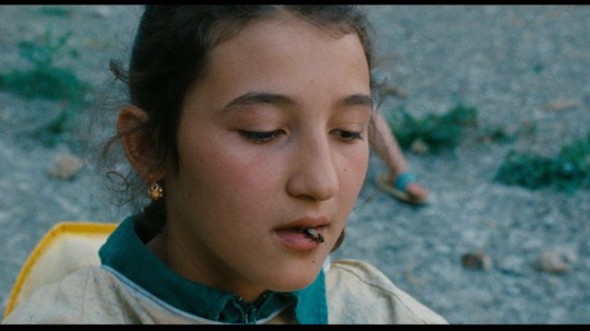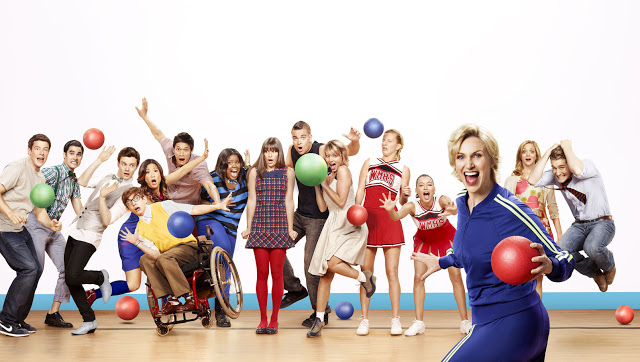In a scene early in Italian writer-director Alice Rohrwacher’s The Wonders the main character, an adolescent girl named Gelsomina (a radiant Maria Alexandra Lungu), her short-tempered beekeeping, farmer father (Sam Louwyck), her slightly younger sister Marinella (a charming Agnese Graziani) and her two youngest sisters, twins who delight in not doing what they’re told and making messes, are taking a break from the hard work of the farm to splash and scream in an impossibly crystalline body of water. Then a man, fully dressed in black pants and shirt makes his way through a shallow lagoon and tells them they must be quiet. “We’re shooting,” he says. When they follow him back to an idyllic small waterfall set against a backdrop of a rock cliff, we see “the shooting” isn’t the hunters we heard at the beginning of the film but a camera crew and a beautiful, white-wigged, costumed, famous TV host (Monica Bellucci) shooting a promo for a new reality TV series that will take place in the region and feature local, farming families competing against each other on camera for a large cash prize.
“Countryside Wonders will be here,” the host announces to the camera and even after the shoot is finished, Gelsomina who, as the oldest, is her father’s main helper in transporting the bees, collecting honey and even removing stingers from his neck, can’t stop staring at the host who gives her one of the jeweled clips from her wig. Gelso wants the family to be part of the competition, but her father, Wolfgang, whose Italian is clearly not his first language and seems to have some vaguely apocalyptic beliefs that have driven him into farming with his family in the countryside, says, “We don’t need that crap.”
In some ways Wolfgang could be a stand-in for all the directors and other outsiders who naively idealize and misinterpret contemporary rural settings and the business of farming. Rohrwacher shows us not just the hard work and financial precariousness of the farm, that just one forgotten chore can potentially put into ruin, but also little slights, like when a customer at the farmers’ market asks if the price of the farm’s honey has gone up, in a tone that implies it’s not worth what the family is charging.
Wolfgang’s neighbor, who grew up in the area, is more philosophical about the reality show, “Maybe we will get some jobs or some tourists.” When he’s on the show, wearing the ridiculous costume the producers force all of the contestants into, he knows just what role he should play, complimenting the host, telling her he’s always wanted to be on her show, lamenting his status as a bachelor and getting the women in his family to sing a “traditional” song for the audience. Gelsomina’s stunt, in which she lets bees crawl out of her mouth while the troubled, 14-year-old boy who lives with the family whistles, is met with much less enthusiasm from both the host and the live audience.
The Wonders could also refer to the film’s gorgeous cinematography shot by Hélène Louvart, whether the scene includes that unnaturally glass-like lake, the crumbling farmhouse, the Tuscan countryside or the open, tender faces of the women and girls (including the girls’ mother, Angelica, played by the director’s sister, Alba Rohrwacher). The beekeeping scenes are surprisingly absorbing, as Gelsomina in her protective suit removes the swarming insects from the thick branch they coat into an open container or finds a pile of dead bees and in the bottom of another and declares them, “poisoned.” I have only a slight fear of bees, but I shuddered at some at these scenes, so anyone with a more serious phobia might want to look away. And anyone who has ever questioned the sanitary standards of small farms will want to look away from a number of scenes showing the gathering of honey in this family operation.
As beautiful and well-acted as the film is, I couldn’t help thinking once the credits rolled, “Is that it?” Although the film has opportunities for great emotional sweep it consistently avoids them by deliberately cutting away or downplaying action that would engage us more fully with these characters and their story. In some shots Lungu looks like she could have been painted by Modigliani and the film itself is more of a static portrait than an emotionally moving story. We spend a lot of time looking into Lungu’s face, but besides her desire to be on TV and get closer to the farmhand, we never really find out what she’s thinking.
[youtube_sc url=”https://www.youtube.com/watch?v=aEOS5iy0Y4M” iv_load_policy=”3″]
Stateside, another new film from a women-writer director that takes place far from the city is Natalia Leite’s Bare. Glee’s Dianna Agron and Paz de la Huerta (believably androgynous and a little grubby) are respectively, Sarah, a meek, young woman in small-town Nevada, working (and getting fired from) a series of menial jobs and Pepper a sexy, shoplifting drifter in a truck.
Inside this film’s sometimes over-the-top melodrama it has some acutely observed moments, like when Sarah’s best friend disparages a woman they both know, then over a period of time, the two of them become best friends and Sarah is the one they whisper about. We see the aimless wandering of the group of slightly past-high-school kids who don’t have anything like college plans, drinking, driving and shouting in the wide Nevada deserts and canyons. Other films show scenes like these only as preludes to disaster: this one just lets its bored, restless characters blow off steam.
Agron and de la Huerta have great chemistry and unlike many similar films about young women together, Bare doesn’t shy from showing these two characters having sex and, at least on Sarah’s part, falling in love. The film also has a more realistic take on working in a strip club than we are used to seeing in films, though the way the film equates dancing naked for money as degradation, the same way it makes Sarah’s sexual awakening with Pepper coincide with her being able to really let loose onstage, is a little retro. Agron is a lot better than I expected her to be (Glee isn’t exactly renowned for its great dramatic performances) and the film is beautifully shot (by Tobias Datum) but, as is too often the case with both indie and Hollywood films, the script is nowhere near the level of the performances or cinematography–and a good script is what makes a good movie. Maybe someday both Hollywood and the indie world will learn this lesson.
[youtube_sc url=”https://www.youtube.com/watch?v=x8p5RhFZTm0″ iv_load_policy=”3″]
Ren Jender is a queer writer-performer/producer putting a film together. Her writing besides appearing every week on Bitch Flicks has appeared in The Toast, xoJane and the Feminist Wire. You can follow her on Twitter @renjender.















